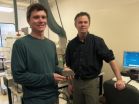(Press-News.org) CHAMPAIGN, Ill. — Using detailed land analysis, Illinois researchers have found that biofuel crops cultivated on available land could produce up to half of the world's current fuel consumption – without affecting food crops or pastureland.
Published in the journal Environmental Science and Technology, the study led by civil and environmental engineering professor Ximing Cai identified land around the globe available to produce grass crops for biofuels, with minimal impact on agriculture or the environment.
Many studies on biofuel crop viability focus on biomass yield, or how productive a crop can be regionally. There has been relatively little research on land availability, one of the key constraints of biofuel development. Of special concern is whether the world could even produce enough biofuel to meet demand without compromising food production.
"The questions we're trying to address are, what kind of land could be used for biofuel crops? If we have land, where is it, and what is the current land cover?" Cai said.
Cai's team assessed land availability from a physical perspective – focusing on soil properties, soil quality, land slope, and regional climate. The researchers collected data on soil, topography, climate and current land use from some of the best data sources available, including remote sensing maps.
The critical concept of the Illinois study was that only marginal land would be considered for biofuel crops. Marginal land refers to land with low inherent productivity, that has been abandoned or degraded, or is of low quality for agricultural uses. In focusing on marginal land, the researchers rule out current crop land, pasture land, and forests. They also assume that any biofuel crops would be watered by rainfall and not irrigation, so no water would have to be diverted from agricultural land.
Using fuzzy logic modeling, a technique to address uncertainty and ambiguity in analysis, the researchers considered multiple scenarios for land availability. First, they considered only idle land and vegetation land with marginal productivity; for the second scenario, they added degraded or low-quality cropland. For the second scenario, they estimated 702 million hectares of land available for second-generation biofuel crops, such as switchgrass or miscanthus.
The researchers then expanded their sights to marginal grassland. A class of biofuel crops called low-impact high-diversity (LIHD) perennial grasses could produce bioenergy while maintaining grassland. While they have a lower ethanol yield than grasses such as miscanthus or switchgrass, LIHD grasses have minimal environmental impact and are similar to grassland's natural land cover.
Adding LIHD crops grown on marginal grassland to the marginal cropland estimate from earlier scenarios nearly doubled the estimated land area to 1,107 million hectares globally, even after subtracting possible pasture land – an area that would produce 26 to 56 percent of the world's current liquid fuel consumption.
Next, the team plans to study the possible effect of climate change on land use and availability.
"Based on the historical data, we now have an estimation for current land use, but climate may change in the near future as a result of the increase in greenhouse gas emissions, which will have effect on the land availability," said graduate student Xiao Zhang, a co-author of the paper. Former postdoctoral fellow Dingbao Wang, now at the University of Central Florida, also co-wrote the paper.
"We hope this will provide a physical basis for future research," Cai said. "For example, agricultural economists could use the dataset to do some research with the impact of institutions, community acceptance and so on, or some impact on the market. We want to provide a start so others can use our research data."
INFORMATION:
The Energy Biosciences Institute at U. of I. and the National Science Foundation supported the study.
Editor's note: To contact Ximing Cai, call 217-333-4935; e-mail xmcai@illinois.edu. The paper, "Land Availability for Biofuel Production," is available online at http://pubs.acs.org/doi/abs/10.1021/es103338e.
University of Illinois research reports that several herbicides used on corn also have good selectivity to Miscanthus x giganteus (Giant Miscanthus), a potential bioenergy feedstock.
"No herbicides are currently labeled for use in Giant Miscanthus grown for biomass," said Eric Anderson, an instructor of bioenergy for the Center of Advanced BioEnergy Research at the University of Illinois. "Our research shows that several herbicides used on corn are also safe on this rhizomatous grass."
M. x giganteus is sterile and predominantly grown by vegetative propagation, or planting ...
WEST LAFAYETTE, Ind. - Large hypoxic zones low in oxygen long have been thought to have negative influences on aquatic life, but a Purdue University study shows that while these so-called dead zones have an adverse affect, not all species are impacted equally.
Tomas Höök, an assistant professor of forestry and natural resources, and former Purdue postdoctoral researcher Kristen Arend used output from a model to estimate how much dissolved oxygen was present in Lake Erie's hypoxic zone each day from 1987 to 2005. That information was compared with biological ...
AUSTIN, Texas — Growing up poor can suppress a child's genetic potential to excel cognitively even before the age of 2, according to research from psychologists at The University of Texas at Austin.
Half of the gains that wealthier children show on tests of mental ability between 10 months and 2 years of age can be attributed to their genes, the study finds. But children from poorer families, who already lag behind their peers by that age, show almost no improvements that are driven by their genetic makeup.
The study of 750 sets of twins by Assistant Professor Elliot ...
University of California, Berkeley, astronomers may have found the missing link between gas-filled, star-forming galaxies and older, gas-depleted galaxies typically characterized as "red and dead."
In a poster to be presented this week at the American Astronomical Society meeting in Seattle, UC Berkeley astronomers report that a long-known "early-type" galaxy, NGC 1266, is expelling molecular gas, mostly hydrogen, from its core.
Astronomers have long recognized the distinction between early-type red and dead galaxies, thought to be largely devoid of gas and dust and ...
RIVERSIDE, Calif. – Geologists at the University of California, Riverside have found chemical evidence in 2.6-billion-year-old rocks that indicates that Earth's ancient oceans were oxygen-free and, surprisingly, contained abundant hydrogen sulfide in some areas.
"We are the first to show that ample hydrogen sulfide in the ocean was possible this early in Earth's history," said Timothy Lyons, a professor of biogeochemistry and the senior investigator in the study, which appears in the February issue of Geology. "This surprising finding adds to growing evidence showing ...
It is well known that pain is a highly subjective experience. We each have a pain threshold, but this can vary depending on distractions and mood. A paper in the International Journal of Behavioural and Healthcare Research offers a cautionary note on measuring perceived pain in research.
There are many chronic illnesses and injuries that have no well-defined symptoms other than pain, but because of the subjectivity in a patient's reporting of their experience of the illness or injury, healthcare workers have difficulty in addressing the patient's needs. Moreover, when ...
People have only 20,000 to 30,000 genes (the number is hotly contested), but they use those genes to make more than 2 million proteins. It's the protein molecules that domost of the work in the human cell. After all, the word protein comes from the Greek prota, meaning "of primary importance."
Proteins are created as chains of amino acids, and these chains of usually fold spontaneously into what is called their "native form" in milliseconds or a few seconds.
A protein's function depends sensitively on its shape. For example, enzymes and the molecules they alter are ...
CHICAGO --- One out of every four or five students who visits a university health center for a routine cold or sore throat turns out to be depressed, but most centers miss the opportunity to identify these students because they don't screen for depression, according to new Northwestern Medicine research.
About 2 to 3 percent of these depressed students have had suicidal thoughts or are considering suicide, the study found.
"Depression screening is easy to do, we know it works, and it can save lives," said Michael Fleming, professor of family and community medicine ...
In the vast ocean where an essential nutrient—iron—is scarce, a marine bacterium that launches the ocean food web survives by using a remarkable biochemical trick: It recycles iron.
By day, it uses iron in enzymes for photosynthesis to make carbohydrates; then by night, it appears to reuse the same iron in different enzymes to produce organic nitrogen for proteins.
The bacterium, Crocosphaera watsonii, is one of the few marine microbes that can convert nitrogen gas into organic nitrogen, which (just as it does on land) acts as fertilizer to stimulate plant growth in ...
When their romantic partners are not quintessentially masculine, women in their fertile phase are more likely to fantasize about masculine-looking men than are women paired with George Clooney types.
But women with masculine-looking partners do not necessarily become more attracted to their partners, a recent study co-authored by a University of Colorado at Boulder researcher concludes.
Meanwhile, a man's intelligence has no effect on the extent to which fertile, female partners fantasize about others, the researchers found. They say the lack of an observed "fertility ...




